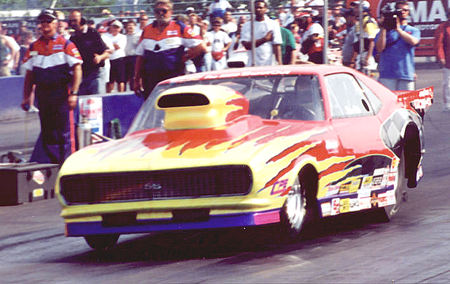|

At the IHRA Autumn Nationals the nitrous oxide injected
Pro Modifieds finally broke into the 6.20 zone. The honor of being the
first nitrous car in the 6.20s went to Mitch Stott with a 6.284 that
he recorded in qualifying. But the quickest car and driver combination
in the nitrous ranks was race winner Steve Vick and his '69 Camaro.
Vick ran a string of 6.20s and 6.30s at speeds of over 227-mph, including
a record elapsed time of 6.268 and a best speed of 228.31. Vick was
the only nitrous car to go into the 6.20 zone twice. He ran a 6.294/227.77
in a final round win over Quain Stott.
Vick gave much of the credit for his performance to his Tommy Mauney
race car, his Gene Fulton engine that features a new design of cylinder
heads developed by Fulton, and a year of hard work.
According to several sources, a lot of the credit for the nitrous cars
breaking into the '20s has to go to the new Fulton cylinder heads. Those
sources say that Fulton's heads have the valve location moved in such
a manner that the hot spots that traditionally cause detonation in nitrous
oxide-injected motors are greatly reduced in this head.
Despite the fact that Vick got his second win of the season there,
the Carolina-based racer wasn't thrilled by the events at Rockingham,
specifically the low, low 6.20s at over 234 run by Fred Hahn in Jim
Oddy's supercharged 'Vette or the 6.20 recorded by Troy Critchley in
Johnny Rocca's '49 Merc.
"They (IHRA) need to adjust the Pro Mod rules a little more to really
make things even for both types of cars," Vick said. "A friend of mine
connected with a NASCAR engine program has told me that the blower cars
develop 400-500 more horsepower than the nitrous cars. When I see Fred
(Hahn) go out on a pass, shake the tires, get sideways and still run
a '20 at over 230-mph I'm sure my friend is right.
"I'll tell you this for sure," Vick continued "If they (IHRA) don't
do something to even up the competition, a lot of nitrous guys I know
are going to have supercharged engines next year. I've got a TM (Tommy
Mauney) car setting here in my shop set up for a blower motor if the
rules aren't changed for next year."
When asked if more cubic inches for the nitrous cars, which has been
rumored, was a possible fix Vick answered an emphatic no.
"All that would accomplish is obsolete both of the $65,000 engines
I have here and besides a couple of guys I know who run the Quick Eight
races around here have tried the big motors and they just aren't anymore
powerful than what we have now."
Vick went on to say that he couldn't just change the crank, rods and
pistons in his current block to make it bigger that he would have to
buy a different block with a raised camshaft from Sonny Leonard to make
a bigger cubic inch engine.
"In the engines I'm running now the crank is just about hitting the
camshaft. I just think the blower cars have two-tenths advantage on
the nitrous cars and that with a simple $125 pulley change they can
be even quicker. The nitrous racers have worked all year long on our
engine combination just to get to the twenties and all they (the supercharged
racers) have to do is change a pulley or a gear to go faster. I can't
even use a fourth stage of nitrous without burning up my engine.
"I hope they (IHRA) do something. I think these (Pro Mod) cars are
too fast and quick. I didn't like the way it felt in the car when I
ran a 6.26/227. It was just too fast. I don't think these cars are designed
to go that fast."
Steve Vick may have gotten at least part of what he wanted from the
IHRA rules makers as for 2001 IHRA has restricted the cylinder heads
for the supercharged Pro Modifieds as well as requiring them to weigh
50 lbs more than the nitrous cars.
Vick's Quick Lap
| 60-ft |
330-ft |
660-ft |
1000-ft |
1/4 mile |
| 1.047 |
2.735 |
4.101/181.88 |
5.308 |
6.268/227.88 |
|